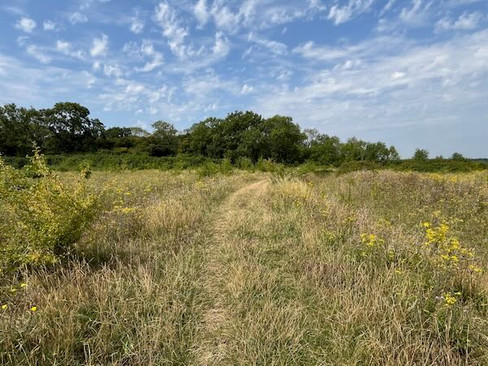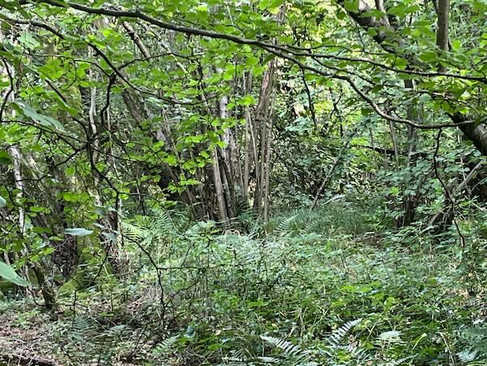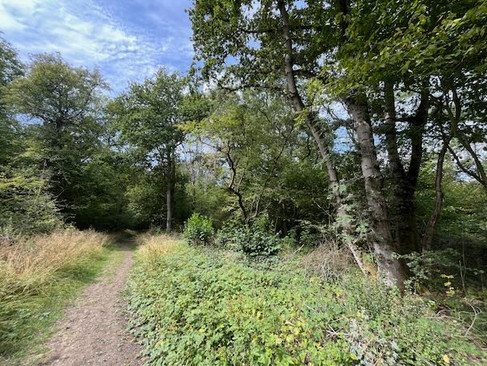Mature greens of August
- Barrie Galpin

- Aug 18
- 4 min read
Barrie Galpin

People come to Short Wood to see bluebells in spring and then again in autumn for the colourful leaves. But there's an attraction in this fragment of the former Rockingham Forest at all times of the year - including even the tail end of summer.
It was going to be the fourth heatwave of the year and we weren’t even halfway into August yet. The morning is cloudy, but temperatures are forecast to be in the 30s by mid-day. So with the dog I set off early in search of shade, heading towards the rather badly-named Short Wood, just south of Southwick. Already most of the fields have been harvested, with yellow-brown stubble and carefully wrapped straw bales. Some farmers are harrowing.
I park in the shade near the water tower and enter the reserve through the tall deer fence. Already the sun is beginning to break through and in the distance I can see two kites lazily wheeling. The first part of the Wildlife Trust (WT) reserve goes through Miley’s Ride, named for a former volunteer who left funds so that the Trust could buy this Field and extend the wood. Today this field is mainly yellow - yellow flowers, yellow grass, yellow sky and yellowing Hawthorne bushes, testament to this driest of summers that we’ve had this year.
As we enter the wood the temperature and dominant colour changes. Here everything is green, not the vibrant mixed greens of spring, but a solid late summer end-of-season green. I remember that I last visited here over a year ago in bluebell time. Then the WT's volunteer warden, Keith Alvey ,led a guided walk for us through the wood and we marvelled at the blankets of blue florets nodding in the spring breeze. I remember thinking that, as well as the blue, there were probably Fifty Shades of Green that day, but now it seems to be just one uniform, rather tired-looking colour - the muted greens of August.
In find myself thinking that in some ways this is the least satisfactory time to walk in woodland, but then I correct myself. After all the shade is coolly delicious today and everything is silence and restful. There’s virtually no bird song. Just an occasional chirp from families of young Blue and Great Tits moving through the bushes. And then without warning they are joined by the clear distinctive calls of a nearby family of Nuthatches. Moments later the silence is broken again by the far off yaffle of a Green Woodpecker.
The Wildlife Trust looks after this Ancient Woodland really nicely with gentle, fairly subtle management. There is a network of rides providing a choice of paths – cut certainly, but not very often. Occasionally there are more open glades where volunteers have cut back some of the vegetation. Here the sun beams through more strongly, allowing new growth to come up in patches between the piles of deadwood that have deliberately been left behind after the volunteers’ winter work-parties.
Around the whole wood there is a tall deer fence which certainly seems to have kept the large herds of Fallow Deer away from the young growth. In many parts of Rockingham Forest there is a clear browse line a few feet above the ground showing how high the deer are able to reach as they despoil the understory. But here the deer fence has largely done its job and low-level plants are flourishing under the trees. At one point there’s a shooting seat - a reminder that Muntjac Deer are very good at getting under even the strongest fencing.
At the far end of Short Wood, another gate leads out to a public footpath. Across all the large surrounding fields to the south and west of this oasis of woodland, the landowner grows a crop for bio-energy, which I think is called Miscanthus. Originally from south Asia, I[it’s a very tall type of grass which, once established, can be harvested productively for 15-20 years. You can find out more about it here https://www.crops4energy.co.uk/miscanthus/
It is said locally that the crop from these fields, north of Glapthorn village, goes to help fuel the UK's largest renewable power station at Drax near Selby in Yorkshire. Some say Miscanthus is beneficial for some wildlife but I certainly can’t see much sign of wildlife there today as I look out across the heat-haze from the shade of the woodland. I’ll not venture out there today.
I do get to wondering when these fields were cleared of what was almost certainly former wood pasture, coppiced or high-canopy woodland. I suppose that, over many decades, bigger and bigger fields were carved out in attempts to grow better and better food. Then not too many years agao the economics must have suggested that establishing bio-fuel would be a better bet. I wonder whether it is better? Better for the planet?
Thank goodness that Short Wood remains, a remnant of the much wider forest. When we walk there we are privileged to experience something of the former heritage of this area and I for one, don’t come here often enough. Even in late summer this is a special place, but by October the mature muted greens of August will no doubt have changed to a vibrant palette of oranges, browns and reds. I make up my mind that I really must come back and enjoy this special place in autumn.
See you there?
For more information about Short Wood including maps and access arrangements please visit the WildLife Trust BCN website here. https://www.wildlifebcn.org/nature-reserves/short-wood-and-southwick-wood













































Comments